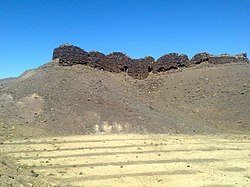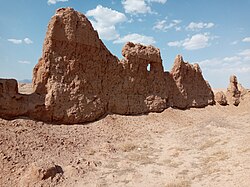| Zibad Castle | |
|---|---|
| Gonabad | |
 | |
| Site information | |
| Owner | National heritage Iran |
| Condition | Ruins |
| Location | |
| Coordinates | 34°16′35″N58°29′15″E / 34.27639°N 58.48750°E |
| Grid reference | grid reference TQ785256 |
| Site history | |
| Built by | Sasanian Empire |
| Materials | Sandscript stone |
| Demolished | Post in War |
| Battles/wars | Davazdah Rokh and Nizak tarkhan |


Zibad Castle is one of the four historical monuments of Zibad, Iran, located in the Kakhk district of Gonabad County, in the Razavi Khorasan Province. It is believed to be the last refuge of Yazdegerd III, whose death signaled the collapse of the Sasanian Empire and the conquest of pre-Islamic Iran. In 2001, the castle was registered as a national heritage property. Zibad Castle has also been nationally registered under the name of Shahab Castle since 2002.








































